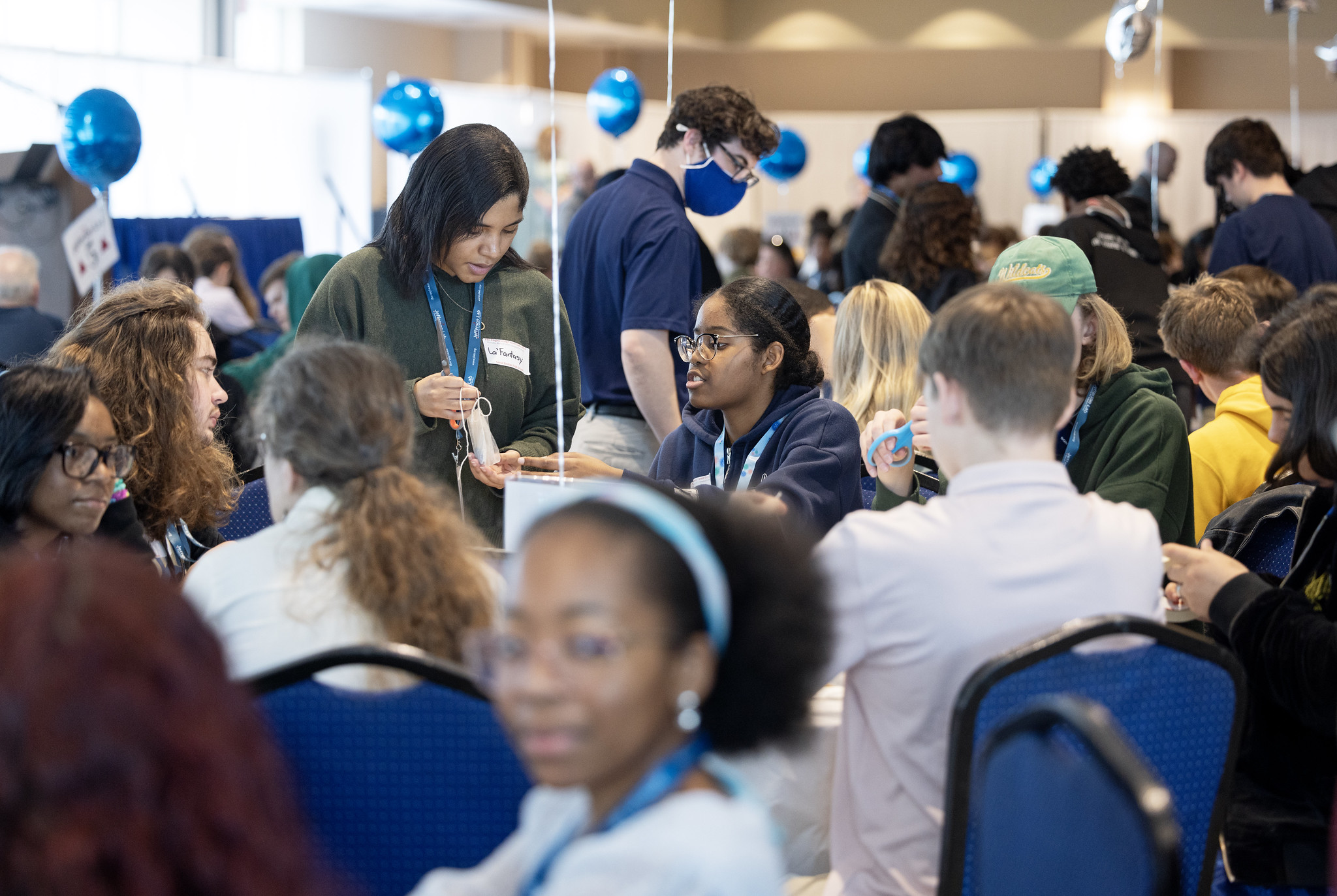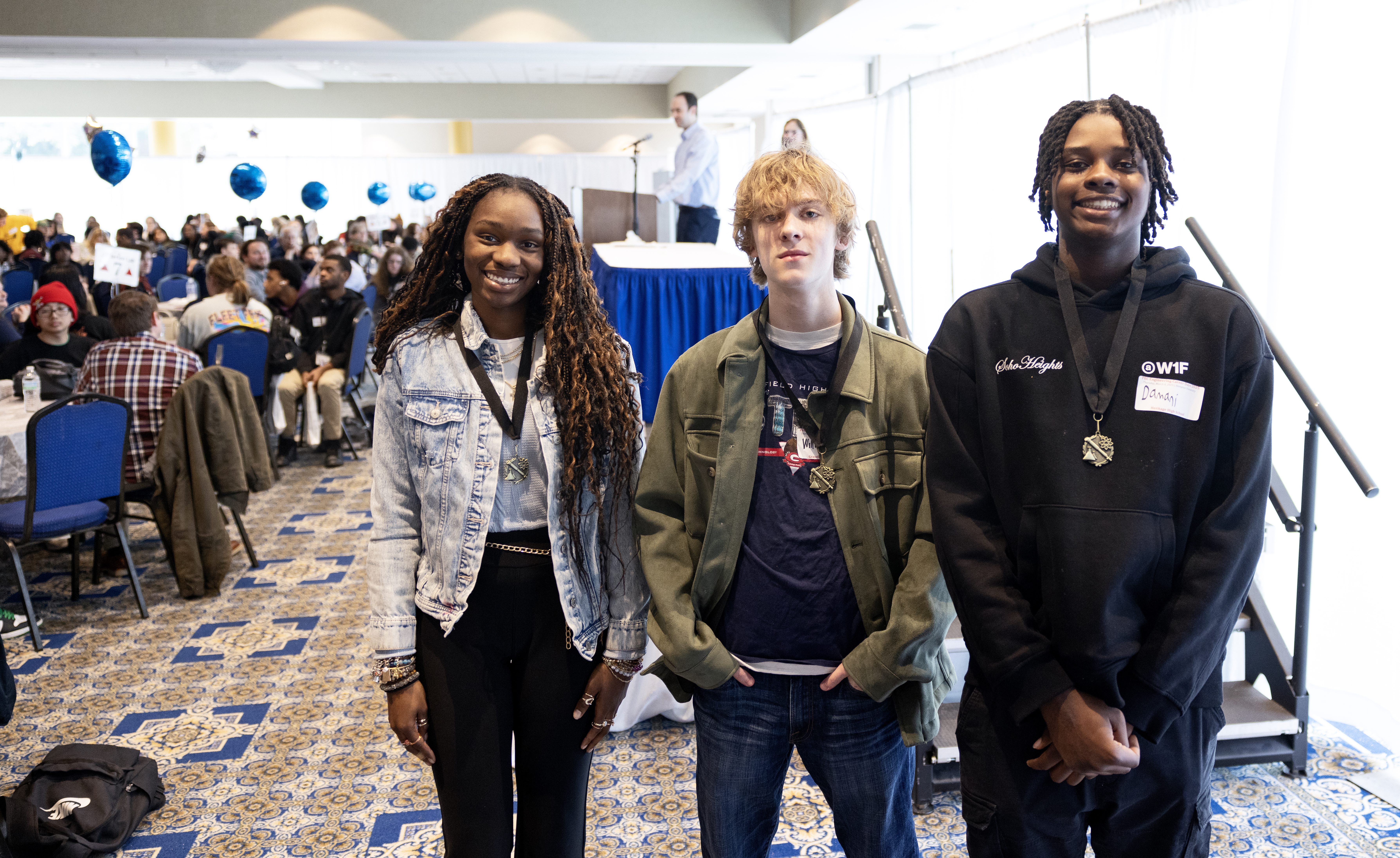Students pick up paperclips using an electromagnet crafted from a large nail, copper wires and a battery during Engineering Career Days at Hampton University on March 6, 2025. (Jefferson Lab photo/Aileen Devlin)
Jefferson Lab teams up with local partners to showcase the variety of paths from high school to careers in STEM
HAMPTON, VA – Whether building ships, planetary landing systems or electromagnets, working within the laws of physics requires thinking outside the box.
That creative energy resonated among hundreds of high school students participating in Engineering Career Days, an event hosted this year by the U.S. Department of Energy's Thomas Jefferson National Accelerator Facility in collaboration with NASA's Langley Research Center and Newport News Shipbuilding, a division of HII.
The event was held at Hampton University and featured more than 35 experts from Jefferson Lab, NASA Langley, and HII. “Career table” sessions exposed local students and teachers to a wide array of engineering disciplines — mechanical, chemical, computing, aerospace and nuclear, to name a few. Jefferson Lab Chief Operating Officer Johnathon Huff delivered the keynote address, and students tested their wits in hands-on challenges based on each organization’s mission.
Engineering Career Days is an annual celebration of National Engineers Week, sponsored by the Peninsula Engineers Council. The event began in 2007 and Jefferson Lab, committed to educating the next generation of professionals in science, engineering, technology and math (STEM), has participated since 2015.
“Students are our future,” said Jefferson Lab Science Education Project Lead Carol McKisson, the lab’s coordinator for Engineering Career Days. “They may decide to go into engineering or say, ‘Nope, this is not for me.’ Either way, they're going to be in the workforce in a few years and we're preparing them for that.”
But before getting to flex their creative muscles, participants got a look inside “the box.”

First, a Message
It’s not often that a keynote speaker carries a flat-screen television to the stage while he’s being introduced.
After taking the mic and thanking the event’s organizers, Huff used the TV — and the components inside — to lead an interactive discussion on how everyday technologies have evolved since the days of cathode-ray tubes.
“Now, a cellphone can do everything a TV can, but what’s the difference?” Huff asked the crowd. “Engineers. They change people’s lives forever.”
Huff, in charge of business functions at Jefferson Lab since 2022, earned his Ph.D. in industrial and systems engineering from Mississippi State University after bachelor’s and master’s degrees in electrical engineering from the Georgia Institute of Technology and Drexel University, respectively.
Huff worked at Intel Corporation and Lockheed Martin before joining the DOE at Sandia National Laboratories, where he held leadership roles in research and development (R&D) and operations. One of his first R&D projects was developing technologies to support the warfighter. He noted that joining Jefferson Lab has given him the opportunity to collaborate with many talented engineers working on a one-of-a-kind accelerator that pushes the boundaries of what humanity understands about the nature of matter.
Huff said a thirst for knowledge took him places he never thought he’d go, including internships with Microsoft, NASA Johnson Space Center and semiconductor producer Micron Technology, Inc.
His advice for students was that if they find something that interests them, to dig into it and pursue it because one never knows where it will lead. He told them to not give up in the face of challenges and learn everything they can.
"Don’t be afraid to ask for help,” Huff said. “Don't be afraid to raise your hand and say, ‘I don't know,’ because many times, there are other people who have the exact same questions but are just afraid to ask.”

Battle of Wits
After that look inside “the box,” students were asked to think outside the box in a series of design challenges.
HII’s Newport News Shipbuilding challenge tasked students with building small boats that were buoyant in a tub of water when weighed down. The materials on hand were household items such as aluminum foil, wood corks and drinking straws — each assigned a cost.
“Seeing teams collaborate, problem-solve and enhance their communication skills was a big success,” said Jose Naranjo, an HII mechanical engineer who works on systems that support nuclear propulsion for Virginia-class submarines. “The main challenges were managing time and staying within budget, but those pushed students to think critically.”
At NASA Langley’s tables, students developed landing devices that could deliver a small payload safely to the "surface" (the floor) from about 6 feet high. Their supplies were also everyday items, including foil, paper, straws, ice cream sticks and string.
“The students jumped right in, forming teams with people they didn't know before,” said Julia Cline, an aerospace engineer who works on structural concepts for autonomous in-space assembly and space nuclear propulsion. “They really embraced the engineering design process and the ability to find a solution, learn from it and improve their design.”
In Jefferson Lab’s section, students crafted electromagnets using a battery, a large nail and insulated wires. The goal was to lift as many paperclips as possible.
“The twist was that the students were not allowed to use electronic devices,” said Jake Magnin, a cryogenics electrical engineer who works on the refrigeration systems that enable Jefferson Lab’s nuclear physics research. “Choosing how to wire the magnet, test it, and position it were decisions they had to make on their own.”

Blueprint for Success
William Crosby, a sophomore in the Governor’s STEM Academy at Grassfield High School in Chesapeake, and Da’Ziyah Hill, a junior at Bethel High School in Hampton, were on the team that won Jefferson Lab’s magnet challenge. The design lifted an average of 100 paperclips over three attempts.
How? After building a strong-enough magnet, the team explored the mechanical aspects of lifting paperclips by the bunch.
“Once we figured that out, we worked on finding the best setup that could lift them all in terms of weight,” Crosby said. “I like finding creative solutions.”
Hill said adjusting on the fly factored into their success.
“There was a lot of trial and error,” Hill said. “We made sure to communicate efficiently and listen to each other's ideas. It was difficult managing our time, but we stayed positive and focused as a team.”
Their subject matter expert was Anne Payne, a structural engineer who helps keep Jefferson Lab’s buildings and roads in top condition.
“It was great to watch the enthusiasm,” Payne said. “Even students who were not into the science could be seen geeking out a little. It was an excellent day.”
For more photos, visit Jefferson Lab’s Flickr page. For more information, contact McKisson at carolm@jlab.org.
Further Reading
Hampton Roads Engineering Career Days Event Offers a Cyber Challenge, “Phun Physics” and STEM Career Advice
Science Education at Jefferson Lab
HII | Global, All-Domain Defense Provider
Langley Research Center - NASA
PEC, Peninsula Engineers Council
2025 Engineering Career Day | Flickr
Contact: Matt Cahill, Jefferson Lab Communications Office, cahill@jlab.org


